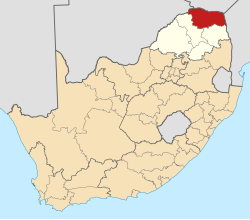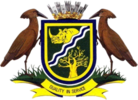The Vhembe District Municipality (Venda: Masipala wa Tshiṱiriki tsha Vhembe; Tsonga: Masipala wa Xifundza xa Vhembe) is one of the 5 districts of the Limpopo province of South Africa. It is the northernmost district of the country and shares its northern border with the Beitbridge District in Zimbabwe and on the east with the Gaza Province in Mozambique. Vhembe consists of all the territories that were part of the former Venda Bantustan; however, two large densely populated districts of the former Tsonga homeland of Gazankulu, in particular, Hlanganani and Malamulele, were also incorporated into the municipality, hence the ethnic diversity of the district. The seat is Thohoyandou, the capital of the former Venda Bantustan. According to the 2011 census, the majority of the municipality's 800,000 inhabitants spoke TshiVenda as their mother language, while 400,000 spoke Xitsonga as their home language. However, the Tsonga people form the majority south of the Levubu River, while the Venda are the minority south of Levubu at 15%. The Sepedi speakers number 27,000. The district code is DC34.
Vhembe | |
|---|---|
 Location in Limpopo | |
| Coordinates: 22°56′S 30°28′E / 22.933°S 30.467°E | |
| Country | South Africa |
| Province | Limpopo |
| Seat | Thohoyandou |
| Local municipalities | |
| Government | |
| • Type | Municipal council |
| • Mayor | Nenguda Dowelani[1] |
| Area | |
• Total | 25,597 km2 (9,883 sq mi) |
| Population (2011)[2] | |
• Total | 1,294,722 |
| • Density | 51/km2 (130/sq mi) |
| Racial makeup (2016) | |
| • Black African | 98.7% |
| • Coloured | 0.2% |
| • Indian/Asian | 0.4% |
| • White | 0.8% |
| First languages (2011) | |
| • Venda | 67.2% |
| • Tsonga | 24.8% |
| • Northern Sotho | 1.6% |
| • Afrikaans | 1.3% |
| • Other | 5.1% |
| Time zone | UTC+2 (SAST) |
| Municipal code | DC34 |
History
editThis section needs additional citations for verification. (August 2023) |
Vhembe is settled by the Venda people who constitute the majority of the population of Vhembe. Later, from around 1820 onwards, the Tsonga people started to invade from the south east and are today a majority in the whole southern and eastern part of Vhembe, which are known today as Malamulele (in the east of Vhembe) and Hlanganani (in the south of Vhembe). At the same time, the Boer Voortrekkers arrived in Vhembe, at around 1836. Venda communities are only found in Vhembe district and as a result, there are no existing Venda communities or villages outside the district. Vhembe means Limpopo river in the Venda language.
Before the renaming of Limpopo Province in 2002, the name Vhembe was submitted to the Limpopo legislature as one of the desired names for the new Province but the majority of the members of the Legislature voted against the name Vhembe in favour of the name Limpopo. The Dzata ruins in Thulamela Local Municipality once served as the main settlement and capital of the Venda empire which had dominated the area during the 18th century.
Boer settlement of the territory began in the early 19th century and gradually upsurged throughout the late 19th century. By the turn of the 20th century, the Soutpansberg was taken by the Boers from the Venda rulers, making it one of the last areas in the future republic of South Africa to come under white rule. During the apartheid era, the bantustan of Venda (declared independent in 1979) was established in the eastern part of the Vhembe area, and was reintegrated into the country in 1994. The former bantustan capital, Thohoyandou (named after a chief that had led the expansion of the Venda empire in the 18th century) is the current seat of the Vhembe district.
On 11 December 2008, Vhembe was declared a disaster zone by the Limpopo government due to the spread of cholera from across the Zimbabwean border to the district.
The Vhembe region became the Vhembe Biosphere Reserve in 2009, which was officially declared a biosphere reserve in 2011.[4] The reserve includes the Blouberg Range, the Kruger National Park, the Philip Herd Nature Reserve,[5] the Nwanedi Nature Reserve,[6] the Makgabeng Plateau, the Makuleke Wetlands, the Mapungubwe Cultural Landscape and the Soutpansberg.[7]
Geography
editThe main geographical feature of the district is the Soutpansberg mountains.
Neighbours
editVhembe is surrounded by:
- Mozambique to the east
- Zimbabwe to the north
- Botswana to the north-west
- Mopani (DC33) to the south
- Capricorn (DC35) to the south-west
Local municipalities
editThe district contains the following local municipalities:
| Local municipality | Population | % | Dominant language |
|---|---|---|---|
| Thulamela | 381 696 | 29.58% | Venda |
| Makhado | 516 031 | 39.56% | Venda |
| Collins Chabane | 328 636[8] | 25.48% | Venda |
| Musina | 68 359 | 5.38% | Venda |
Demographics
editThe following statistics are from the census 2011 10% sample.[9]
| Language | Population | % |
|---|---|---|
| Venda | 861 910 | 67.3% |
| Tsonga | 318 973 | 24.9% |
| Northern Sotho | 19 935 | 1.6% |
| Afrikaans | 16 317 | 1.3% |
| Sotho | 12 369 | 1.0% |
| Other | 27038 | 2.1% |
| English | 12994 | 1.0% |
| Ndebele | 4193 | 0.3% |
| Zulu | 1 864 | 1.0% |
| Tswana | 1 179 | 0.1% |
| Xhosa | 660 | 0.1% |
| Swati | 2 412 | 0.2% |
| Sign | 1 205 | 0.1% |
Gender
edit| Gender | Population | % |
|---|---|---|
| Female | 757 501 | 54.4% |
| Male | 645 278 | 45.6% |
Population group
edit| Population group | Population | % |
|---|---|---|
| Black African | 1 272 427 | 98.3% |
| White | 14 168 | 1.1% |
| Indian/Asian | 5 435 | 0.4% |
| Coloured | 1 858 | 0.1% |
| Other | 1 180 | 0.1% |
Age
edit| Age | Population | % |
|---|---|---|
| 00 - 04 | 163 984 | 12.7% |
| 05 - 09 | 142 612 | 11.0% |
| 10 - 14 | 144 313 | 11.1% |
| 15 - 19 | 159 642 | 12.3% |
| 20 - 24 | 130 534 | 10.1% |
| 25 - 29 | 99 850 | 7.7% |
| 30 - 34 | 80 042 | 6.2% |
| 35 - 39 | 71 038 | 5.5% |
| 40 - 44 | 59 394 | 4.6% |
| 45 - 49 | 53 881 | 4.2% |
| 50 - 54 | 45 418 | 3.5% |
| 55 - 59 | 35 508 | 2.7% |
| 60 - 64 | 27 315 | 2.1% |
| 65 - 69 | 21 205 | 1.6% |
| 70 - 74 | 18 526 | 1.4% |
| 75 - 79 | 16 045 | 1.2% |
| 80 - 84 | 13 847 | 1.2% |
| 85+ | 11 916 | 0.9% |
Politics
editElection results
editElection results for Vhembe in the South African general election, 2004.
- Population 18 and over: 621 522 [51.80% of total population]
- Total votes: 386 629 [32.22% of total population]
- Voting % estimate: 62.21% votes as a % of population 18 and over
| Party | Votes | % |
|---|---|---|
| African National Congress | 348 768 | 90.21% |
| Democratic Alliance | 15 553 | 4.02% |
| United Democratic Movement | 5 821 | 1.51% |
| African Christian Democratic Party | 4 687 | 1.21% |
| Pan African Congress | 2 875 | 0.74% |
| New National Party | 2 098 | 0.54% |
| Azanian People's Organisation | 1 767 | 0.46% |
| Independent Democrats | 916 | 0.24% |
| Freedom Front Plus | 864 | 0.22% |
| Inkhata Freedom Party | 585 | 0.15% |
| United Christian Democratic Party | 469 | 0.12% |
| NA | 359 | 0.09% |
| SOPA | 336 | 0.09% |
| PJC | 301 | 0.08% |
| EMSA | 282 | 0.07% |
| CDP | 258 | 0.07% |
| TOP | 198 | 0.05% |
| UF | 191 | 0.05% |
| KISS | 129 | 0.03% |
| NLP | 92 | 0.02% |
| Minority Front | 80 | 0.02% |
| Total | 386 629 | 100.00% |
References
edit- ^ "Executive Mayor". Vhembe District Municipality. Archived from the original on 1 June 2020. Retrieved 16 March 2020.
- ^ a b "Statistics by place". Statistics South Africa. Archived from the original on 13 November 2020. Retrieved 27 September 2015.
- ^ "Statistics by place". Statistics South Africa. Archived from the original on 13 November 2020. Retrieved 27 September 2015.
- ^ "The official launch of the Vhembe Biosphere Reserve". Archived from the original on 2 October 2015. Retrieved 5 April 2012.
- ^ "ArcGIS Web Application". South Africa Protected Areas Register (PAR). Archived from the original on 8 March 2022. Retrieved 12 January 2022.
- ^ "Protected Areas Register (PAR)". Protected Areas Register (PAR) South Africa. Archived from the original on 8 March 2022. Retrieved 12 January 2022.
- ^ UNESCO - Biosphere Reserve Information Archived 17 May 2017 at the Wayback Machine. Accessed 31 July 2023.
- ^ NOTE: official census statistics for Collins Chabane not available (March 2020).
- ^ Statistics South Africa. Census 2011 10% sample
